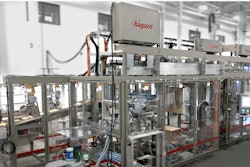Show Daily Exclusive -
The value of domestic shipments rose 14.7% to $9.4 billion in 2020, according to 2021 State of the Industry U.S. Packaging Machinery, a report published by PMMI, The Association for Packaging and Processing Technologies (Central Lobby). Domestic shipments of converting machinery experienced even stronger growth, rising 15.5% to $972 million.
“This is an historic growth rate,” reported Jorge Izquierdo, vice president of Market Development at PMMI, during a media briefing yesterday. He noted growth years typically fall in the 4–5% range.
Exports of packaging machinery accounted for $693 million of the $972 million, an 11% increase over 2019. Imports also increased, rising 13.4% to $2.9 billion. Izquierdo said the order backlog also set a record, $3.14 million at the end of 2020.
The positive trend is expected to continue with double-digit growth this year and a compound annual growth rate (CAGR) of 7% through 2026. For this year, the strongest performance is expected from the household, industrial and agricultural chemicals sector with a CAGR of 8.6% through 2026, followed closely by pharmaceuticals at a CAGR of 8%.
The favorable outlook stems from economic trends, particularly the expected post-pandemic expansion in GDP. Another factor at play is the dominance of millennials in the U.S. population and their divergent preferences with other generations, particularly baby boomers, the next largest group. These diverging tastes encourage adoption of new and flexible packaging machinery.
Packaging machinery purchases also are being driven by workforce challenges, a need for automation, demands for more sustainable packaging and growth in eCommerce.
“Workforce challenges are here to stay,” said Izquierdo. As a result, brand owners are looking for intuitive equipment that “someone off the street could run,” he explained.
Automation is an imperative. The need for automation encourages adoption of robotics, machine vision, artificial intelligence, the Industrial Internet of Things, wireless connectivity and remote services and training yet spurs concerns about cybersecurity.
Sustainability initiatives are fostering more holistic views of the value-chain and optimization of materials and machinery. This is prompting a shift to lightweight flexible packaging, innovations in packaging materials, specification of more energy-efficient packaging machines and the need to optimize equipment to efficiently run the more sustainable materials.
Continued growth in eCommerce will prompt more redesigns of packaging and equipment innovations to accommodate the increased touch points between manufacturer and consumer.
“Workforce challenges are here to stay,” said Izquierdo. As a result, brand owners are looking for intuitive equipment that “someone off the street could run,” he explained.
Automation is an imperative. The need for automation encourages adoption of robotics, machine vision, artificial intelligence, the Industrial Internet of Things, wireless connectivity and remote services and training while spurring concerns about cybersecurity.
Sustainability initiatives are fostering more holistic views of the value-chain and optimization of materials and machinery. This is prompting a shift to lightweight flexible packaging, innovations in packaging materials, specification of more energy-efficient packaging machines and the need to optimize equipment to efficiently run the more sustainable materials.
Continued growth in eCommerce will prompt more redesigns of packaging and equipment innovations to accommodate the increased touch points between manufacturer and consumer.


























